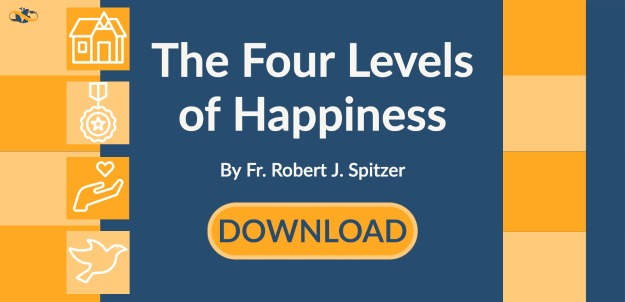“Stop judging and you will not be judged. Stop condemning and you will not be condemned. Forgive and you will be forgiven. Give and gifts will be given to you; a good measure, packed together, shaken down, and overflowing will be poured into your lap. For the measure with which you measure will in return be measured out to you. . . . Why do you notice the splinter in your brother’s eye, but do not perceive the wooden beam in your own?”
—Luke 6: 37- 41
There are many moments or circumstances in our lives that cause us to take stock of our lives, looking for ways to become better people, whether that means becoming more compassionate and thoughtful, a better listener, spouse, friend, worker, and so on. So often, however, it seems that we get in our own way of making positive changes. Why is that?
Thinking Traps: How We Can Easily Misjudge People and Circumstances
Although the human brain is designed to give us a reasonably objective assessment of our environment, we don’t always interpret the information correctly. In this post, we will take a look at five common thinking traps that can trip us up. These traps cause us to misjudge situations, ourselves, and our neighbors. They include jumping to conclusions, mind reading, overgeneralization, externalization, and tunnel vision.
Brain Basics
The human brain is an amazingly complex organ. With over 100 billion neurons–about the same number of stars in a galaxy—the brain receives inputs from the five senses and other neurons in vast quantities. Let’s put this in perspective.
As described in an earlier post, because each neuron has up to 30,000 connections and each connection is capable of sending 5000 bits of information in 3 milliseconds, it means that each neuron can receive up to 150 million bits of information every three milliseconds. It is no wonder then that the brain evolved shortcuts–circuits and pathways—to limit and monitor the amount of information it processes.
Shortcuts Can Get Short-Circuited by Thinking Traps
The image we build of the world and our place in it is built on our experiences (which might include what we learn from others). From there, we build expectations about how the world works using inductive reasoning. The shortcuts used by the brain, however, sometimes allow us to misinterpret or miss critical pieces of information.
In their book The Resilience Factor, Dr. Karen Reivich and Dr. Andrew Shatte, describe eight “thinking traps” that humans commonly fall into.
Let’s look at five thinking traps:
- Jumping to conclusions
- Mind reading
- Overgeneralization
- Externalization
- Tunnel vision
Thinking Trap #1: Jumping to Conclusions
One of the easiest traps we fall into is jumping to conclusions: we make assumptions without relevant data and then act as if our conclusions are certain. Reivich and Shatte call it the umbrella error since all of the traps make different kinds of assumptions. The problem associated with this error is that people react impulsively to situations without confirming the underlying assumption, which often leads to additional problems. This can include spreading false information and might be part of the bad habit of gossip, as Pope Francis reminds us. This can be avoided by treating your assumption as a hypothesis that needs to be verified. Unless a situation demands an immediate response, it is better to verify the information before acting.
Thinking Trap #2: Mind Reading
Mind reading is closely related to jumping to conclusions. More specifically, we assume we know with certainty what others are thinking and act on those assumptions. Often we assume the reverse—that others should know what we are thinking! A quick example from family life can illustrate how this trap works. You come home exhausted from a long and frustrating day at the office, and the leftovers you thought you were going to serve for dinner have disappeared! “Why did you eat that? I was going to use it for dinner,” is a mind-reading response.
Thinking Trap #3: Overgeneralization
Overgeneralization involves attributing problems to global characteristics, such as a person’s character, rather than that person’s action in that particular circumstance. This can lead to rash judgment about a person or their intentions.
Thinking Trap #4: Externalization
Externalization causes us to blame outside influences—other people or circumstances–for a situation or a problem. With this mind trap, the responsibility to make personal changes and take action is ignored.
Thinking Trap #5: Tunnel Vision
When one suffers from tunnel vision, one sees either only negative details of the incoming information or only details that complement one’s viewpoint. Again, this can be about a person or a circumstance. This mind trap binds our understanding of a problem and our ability to generate meaningful solutions.
How We See the World Matters in Overcoming Thinking Traps
Nature may have something to say about the significance of a changing viewpoint. In the spring, summer, and through much of autumn, leaves on the trees filter sunlight through the filigree of branches holding them. As the final brown decaying leaves fall, the view changes dramatically. The landscape beyond becomes visible, and we can see the clouds reflecting the gold, amber, and vermilion rays of the sun as it rises and sets.
Sometimes we need to change how we see things in order to see how to change ourselves.
So when a clouded view of ourselves and others is stripped away—sometimes through suffering, loss, and the pruning that follows mistakes or sinful actions—the view expands, and a vision of what was hidden is revealed.
Reivich and Schatte focus on the psychological necessity of a humble, less rigid view: “Growth and change cannot happen unless you are able to take stock of a situation accurately.” (p. 104)
Or, as Fr. Romano Guardini puts it in the context of the Christian life:
Essentially a soldier, the Christian is always on the lookout. He has sharper ears and hears an undertone that others miss; his eyes see things in a particularly candid light, and he senses something to which others are insensible, the streaming of a vital current through all things. He is never submerged in life, but keeps his head and shoulders clear of it and his eyes free to look upward. Consequently he has a deeper sense of responsibility than others. When this awareness and watchfulness disappear, Christian life loses its edge; it becomes dull and ponderous.
So keep your mind, heart, and eyes open to make the changes you long to see in yourself, and be open to the changes that are taking place in those around you.


